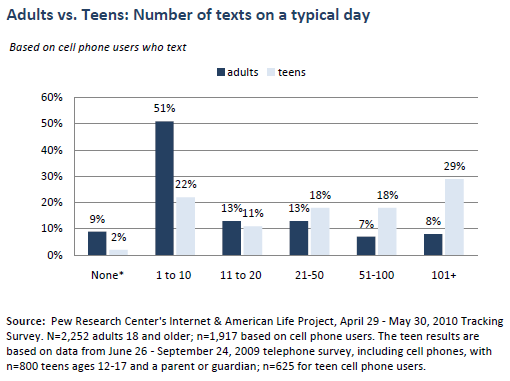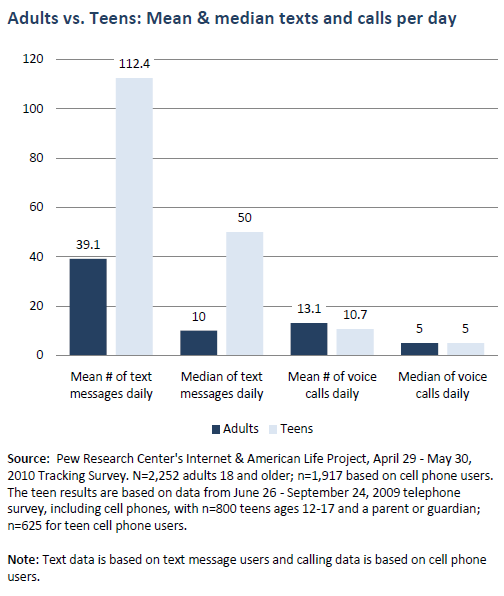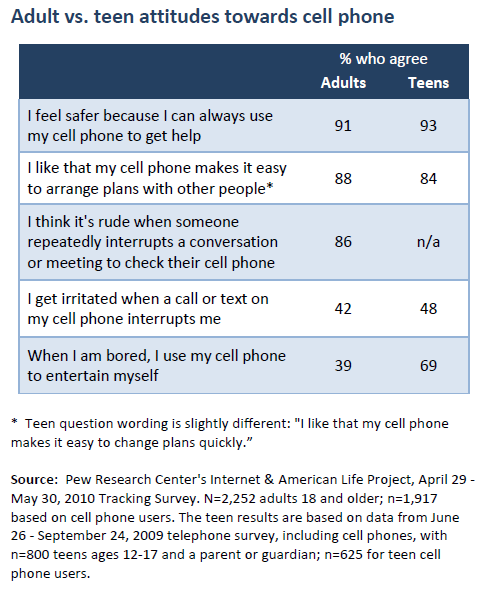Teens are bigger users of text messaging than adults
Conventional wisdom suggests that teens are more enthusiastic users of the cell phone than adults. In practice, teens ages 12 to 17 are indeed more intense users of text messaging than older cell phone users, while they use voice calling in similar manner to adults.
Teens send and receive text messages in numbers that are orders of magnitude greater than what is sent and received by adults. The average teen (even including teens without cell phones) sends and receives five times more text messages a day than a typical adult. A teen typically sends or receives 50 text messages a day, while the average adult sends or receives 10. Fully 31% of teens send more than 100 texts a day and 15% send more than 200 a day, while just 8% and 5% of adults send that many, respectively.

While more than half of all adults with cell phones who text send 1 to 10 text messages a day, just one fifth (22%) of teens send that many messages each day. Even though discrepancies remain between the age groups, adults have seen substantial increases in texting over the past months. Today, the median number of texts sent by adult texters is 10, up from 5 in September 2009. Looked at through a different statistical lens, the mean number of texts sent by adults as of May 2010 is 39.1 up from 29.7 in September 2009.
Teens also differ from adults in some of the purposes behind cell phone usage choices, particularly text messaging. More than half of teen texters (51%) text several times a day “just to say hello and chat” while only about a third (34%) of adults who text send “hello and chat” messages with that frequency.
Teens are also more likely than older adults to have slept with their cell phone on or right next to their bed – fully 84% of teens do this, while 65% of adults 18 and older with a cell phone have done so. Like adults, teens who sleep with their cell phone tend to have a more positive attitude towards the cell phone overall than their counterparts who do not take the phone to bed, and to express beliefs that suggest that the phone is a substantially important tool in their lives. Teens who sleep with their phones are more likely to appreciate the ways it keeps them in touch, makes them feel safer, and are more likely to enjoy the way their cell phone makes it easier to change plans on the fly. They are less likely to turn their phones off when they don’t have to and are just as likely to express irritation with interruptions from their cell phone as those who don’t sleep with their phone. Teens who sleep with their cell phone also do not find it particularly difficult to remember to keep their phone with them.
Teens and adults are just as likely to have received unwanted to spam text messages, with 57% of adult and 54% of teen cell phone users receiving spam texts.
Adults and teens share similar calling patterns
Adults and teens share similar calling patterns, except adults call more often just to say hello and teens call more to check in and report their whereabouts
Adults and teens are much more alike in their use of voice calling from a mobile phone than their text messaging behavior might suggest. The largest segment of each group – 58% of teens and 44% of adults – make and receive 1 to 5 mobile phone calls a day. However, cell-owning adults are more likely than teens to initiate and receive more than 20 calls a day, with 12% of adults making that many calls, compared with just 6% of teens. Consistent with these findings, teens and adults make and receive a median of 5 calls a day, while the mean number of teen calls is 10.7 and the mean for adults is 13.1.

Overall, adults and teens are just as likely to have used their mobile phone to call someone just to say hello and chat, though adults are a bit more likely to do this more frequently, with 26% of cell-owning adults calling to say hello several times a day, compared with 18% of teens with cell phones. Adults and teens show similar calling patterns when they use the phone to have long conversations on personal topics and when they use their cell phone to coordinate an in-person meeting.
Teens are more likely to use the phone to call and report where they are or check someone else’s location; 90% of teens have done so as have 81% of adults. Teens are also more likely to use the phone for school work than adults are to use their phone for professional work. However, of those adults that do use their phone to make and receive calls for work, they use it for that purpose more frequently than teens use their handsets for school.
Teens and adults agree that phones keep them safe and occasionally annoy
Teens and adults agree that phones keep them safe and occasionally annoy, but teens are more likely to fight boredom with their phone.
For the most part, teens and adults share similar attitudes towards their cell phones. Both adults and teens nearly unanimously state (91% of adults and 93% of teens) that their cell phone makes them feel safer because they can always use it to get help. Teens and adults are also just as likely to say that they feel irritated when a call or text on their phone interrupts them – with 42% of adults and 48% of teens expressing irritation.

The one place where teens and adults diverge is over attitudes towards the phone as a stop gap entertainment platform for fighting boredom. Just about 2 in 5 adults (39%) say they use their cell phone to entertain themselves when they are bored. By contrast, nearly 7 in 10 teens with cell phones (69%) say they use their phone to beat back boredom.


